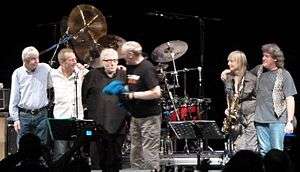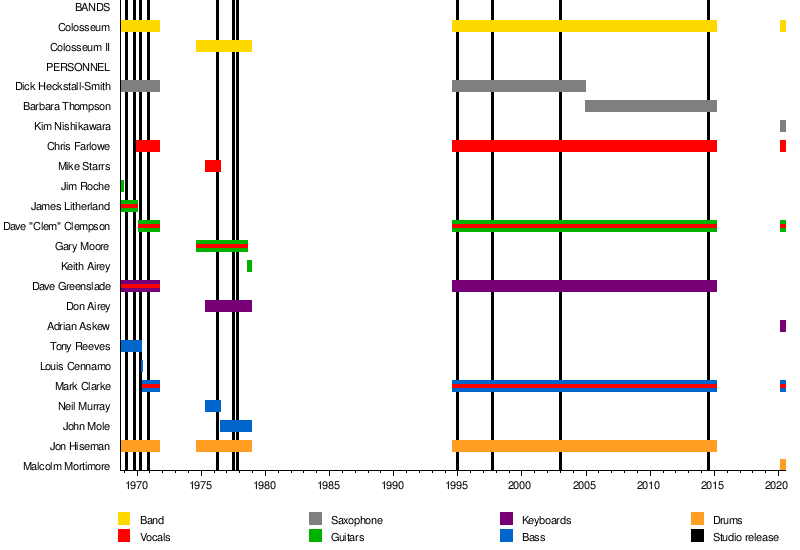Colosseum (band)
Colosseum are a pioneering English progressive jazz-rock band,[2] mixing blues, rock and jazz-based improvisation.[3]
Colosseum | |
|---|---|
 Colosseum in 2010 | |
| Background information | |
| Origin | England |
| Genres | |
| Years active | 1968–1971, 1994–2015, 2020– |
| Labels | |
| Associated acts | |
| Members | Dave "Clem" Clempson Mark Clarke Chris Farlowe Adrian Askew Kim Nishikawara Malcolm Mortimore |
| Past members | Dave Greenslade Dick Heckstall-Smith Jon Hiseman James Litherland Tony Reeves Jim Roche Louis Cennamo Barbara Thompson |
History 1968–1971
Colosseum, one of the first bands to fuse jazz, rock & blues, were formed in Spring 1968 by drummer Jon Hiseman with tenor sax player Dick Heckstall-Smith, who had previously worked together in the New Jazz Orchestra and in The Graham Bond Organisation, where Hiseman had replaced Ginger Baker in 1966. They met up again early in 1968 when they both played in John Mayall's Bluesbreakers, during which time they played on the Bare Wires album. Childhood friend Dave Greenslade was quickly recruited on organ, as was bass player Tony Reeves who had also known both Hiseman and Greenslade since being teenage musicians in South East London. The band's line-up was completed, after lengthy auditions, by Jim Roche on guitar and James Litherland (guitar & vocals), although Roche only recorded one track before departing.
Their first album, Those Who Are About to Die Salute You, which opened with the Bond composition "Walkin' in the Park", was released by the Philips' Fontana label in early 1969. In March the same year they were invited to take part in Supershow, a two-day filmed jam session, along with Modern Jazz Quartet, Led Zeppelin, Jack Bruce, Roland Kirk Quartet, Eric Clapton, Stephen Stills, and Juicy Lucy.[4]
Colosseum's second album, later in 1969, was Valentyne Suite,[5] notable as the first release on Philip's newly launched Vertigo label, established to sign and develop artists that did not fit the main Philips' brand, and the first label to sign heavy metal pioneers Black Sabbath.
For the third album, The Grass Is Greener, released only in the United States in 1970, Dave "Clem" Clempson replaced James Litherland. Louis Cennamo then briefly replaced Tony Reeves on bass, but was replaced in turn by Mark Clarke within a month. Then Hiseman recruited vocalist Chris Farlowe to enable Clempson to concentrate on guitar. This lineup had already partly recorded the 1970 album Daughter of Time.
In March 1971, the band recorded concerts at the Big Apple Club in Brighton and at Manchester University. Hiseman was impressed with the atmosphere at the Manchester show, and the band returned five days later for a free concert that was also recorded. The recordings were released as a live double album Colosseum Live in 1971. In October 1971 the original band broke up.
Interim 1971–1994
After the band split, Jon Hiseman formed Tempest with bassist Mark Clarke; Dave Greenslade formed Greenslade together with Tony Reeves. Chris Farlowe joined Atomic Rooster; and Dick Heckstall-Smith embarked on a solo career. Clem Clempson joined the hit group Humble Pie.
Hiseman formed another group called Colosseum II in 1975, with a stronger orientation towards jazz-fusion rock, which featured guitarist Gary Moore and Don Airey on keyboards. They released three albums before disbanding in 1978.
Reunion 1994–2015
Colosseum reunited in 1994 with the same line-up as when they split in 1971.
Colosseum reunited on 24 June 1994 at the Freiburg Zelt Musik Festival, then, a few months later, they played a concert in Cologne on 28 October at E-Werk which was recorded for a TV Special and later released in 1995 as a CD and video. It was then re-released in 2004 as a DVD. The rejuvenated band then played a lengthy tour of mainly German concerts. A second tour followed in 1997, to promote their new studio album "Bread and Circuses". They also appeared at major festivals in 1998, 1999 and 2000.
In 2003 they toured on the back of "Tomorrow's Blues" CD, followed also by gigs in England in 2004. Hiseman's wife, saxophonist Barbara Thompson, joined the band on various occasions before the death of Dick Heckstall-Smith in December 2004, before becoming a permanent member of the band.[6]
In 2005, there were three memorial concerts for Dick Heckstall-Smith, one in Hamburg Germany and two in England. Then on 24 September 2005 they performed in Moscow, followed by more concerts in 2006. In 2007, the made their first appearance in Japan and returned to play more dates in Germany. Further tours of Europe were made in 2010.
In October 2010, Jon Hiseman's biography, Playing the Band - The Musical Life of Jon Hiseman, was published. In November 2012, a Kindle version (with minor re-edits) of Playing the Band was published.[7]
Colosseum played their "Summer 2011" tour of 22 gigs in Germany, Italy, Austria, Finland and Poland. The tour started in June and ended on 20 August in Germany, Rostock, at Bad Doberan "Zappanale" festival. According to the interview of the bandleader Jon Hiseman, Bad Doberan was the last concert of the band. Their second 'last' concert was in Poland, Slupsk, at "Legends of Rock" festival on 13 August 2011 and the third 'last' concert in Finland, Äänekoski, at "Keitelejazz" festival on the 23 July 2011. These announcements were based on Barbara's worsening Parkinson's condition preventing her from playing. However, with the arrival of new medication, her ability to play was renewed, so those announcements proved to be premature and the band continued to record and play until 2015.
More studio releases followed,[8] as expanded editions of Valentyne Suite and Colosseum Live, and several compilation sets of earlier work. From 2011 to 2014, Colosseum gradually recorded their final album, titled "Time on our Side", which was eventually released late in 2014, to coincide with their final flurry of dates in Germany and the UK. These included 24 concerts during 2014 in Central Europe, starting 23 October at Steinegg Festival, Collepietra, Italy. Followed by concerts in February 2015 before ending on 28 of that month at the Shepherd's Bush Empire, London. At all these concerts, Jon Hiseman confirmed from the stage that this tour would be Colosseum's last.[9]
After 23 years, the band played what Jon referred to as 'the last hurrah!' before a packed and very appreciative audience at the Shepherd's Bush Empire, London on 28 February 2015. Special 'guest' was Ana Gracey, the daughter of Jon Hiseman and Barbara Thompson, who sang her own composition, "Blues to Music", with Chris Farlowe, which was also included on the final Colosseum CD.
Second Reunion 2020–
Colosseum reunited again after the death of Jon Hiseman to play selected shows in 2020. The line-up is Chris Farlowe, Clem Clempson and Mark Clarke joined by Kim Nishikawara (sax), Adrian Askew (keys, organ) and Malcolm Mortimore (drums). [10]
Material loss 2019
On 25 June 2019, The New York Times Magazine listed Colosseum among hundreds of artists whose material was reportedly destroyed in the 2008 Universal fire.[11]
Line-ups
|
Current members
|
Former members
Touring musicians
|
Timeline

Discography
Studio albums
- Those Who Are About to Die Salute You (1969)
- Valentyne Suite (1969)
- The Grass Is Greener (1970) (U.S. release only)
- Daughter of Time (1970)
- Bread and Circuses (1997)
- Tomorrow's Blues (2003)
- Time on Our Side (2014)
Singles
- "Walking in the Park" / "Those About to Die, Salute You" – (1969)
- "Walking in the Park" / "The Road She Walked Before" – (1969)
- "The Kettle" / "Plenty Hard Luck" – (1969)
- "The Daughter of Time" / "Bring Out Your Dead" – (1971)
EPs
- Bread & Circuses – (1997)
- The Kettle – (2001)
Live albums
- Colosseum Live – (1971)
- LiveS The Reunion Concerts 1994 – (1995)
- Live Cologne 1994 – (2003)
- The Complete Reunion Concert – (2003)
- Live05 – (2007)
- Theme for a Reunion – (2009)
- Live At The Boston Tea Party, August 1969 – (2015)
- Live At The Montreux Jazz Festival 1969 – (2020)
- Live At Ruisrock, Turku, Finland, 1970 – (2020)
- Live At Piper Club, Rome, Italy 1971 – (2020)
- Live '71, Canterbury, Brighton & Manchester – (2020)
Compilation albums
- The Collectors Colosseum – (1971)
- Epitaph – (1986)
- Milestones – (1989) (2-CD collection)
- Night Riding – (1990)
- Daughter of Time – (1991)
- The Time Machine – (1991)
- The Ides of March – (1995)
- Anthology – (2000) (2-CD collection)
- Best - Walking in the Park – (2000)
- The Best Of – (2002)
- An Introduction To...Colosseum – (2004)
- Morituri Te Salutant – (2009) (4-CD collection)
DVD
- Colosseum LiveS : The Complete Reunion Concert Cologne 1994 – (2002)
See also
Literature
- Hanson, Martyn: Playing The Band - The Musical Life of Jon Hiseman, Edited by Colin Richardson 2010, London, Temple Music Books, ISBN 9780956686305
References
- Deming, Mark. "Colosseum". Allmusic. Retrieved 20 November 2015.
- Larkin C 'Virgin Encyclopedia of Sixties Music' (Muze UK Ltd, 1997) ISBN 0-7535-0149-X p69 - in which he states 'the commercial acceptance of jazz rock in the UK was mainly due to Colossseum.'
- "COLOSSEUM discography (top albums), MP3, videos and reviews". Progarchives.com. Retrieved 2 July 2015.
- "25 March 1969". Led Zeppelin Timeline. Retrieved 22 January 2011.
- Ben Miler, Colosseum: Valentyne Suite (1969) Archived 23 July 2011 at the Wayback Machine, Hippy.com Archived 21 June 2019 at the Wayback Machine, 14 October 2002.
- "Interview:Jon Hiseman (Colosseum,Tempest,Graham Bond,Jack Bruce)". Hit-channel.com. Retrieved 2 July 2015.
- "Playing The Band eBook: Martyn Hanson, Colin Richardson: Amazon.co.uk: Kindle Store". Amazon.co.uk. Retrieved 2 July 2015.
- "Colosseum2011update". Personal.inet.fi. Archived from the original on 27 September 2011. Retrieved 2 July 2015.
- Hiseman, Jon. "Jon Hiseman's Message to Fans on Facebook". Temple0music.com. Retrieved 7 March 2015.
- Gracey, Ana. "BREAKING NEWS..."
- Rosen, Jody (25 June 2019). "Here Are Hundreds More Artists Whose Tapes Were Destroyed in the UMG Fire". The New York Times. Retrieved 28 June 2019.